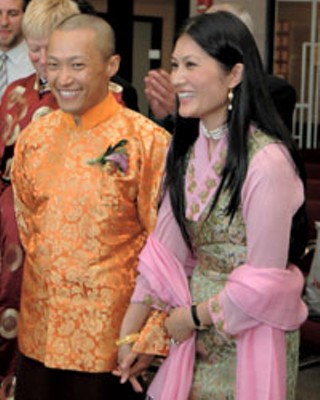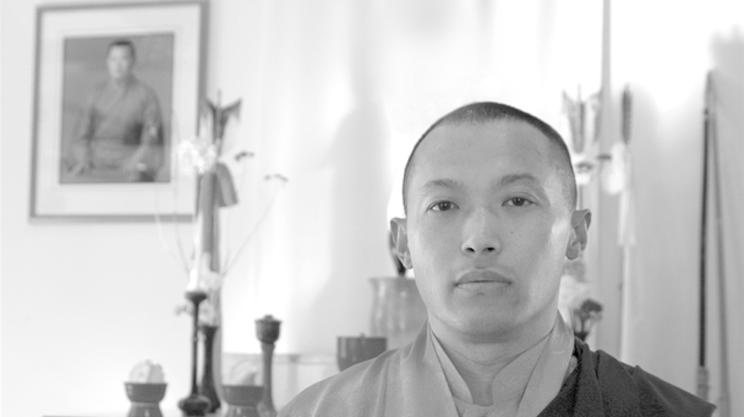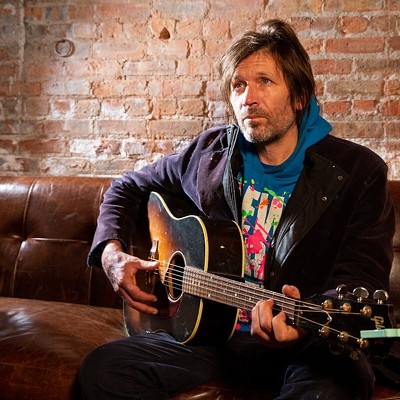There is a rock and roll version of this wedding and it’s probably the one you want to know about. I don’t blame you. I mean, how exciting can reading about a wedding be? Even a $200,000 wedding with two planners, hundreds of volunteers and a 600-pound 25-foot copper dragon sculpture travelling from British Columbia by truck to be here for the event. In the end, it’s just a bride, a groom and some guests.
The rock and roll version of this wedding is the one where the handsome and athletic religious leader—Sakyong Mipham Rinpoche, call him the Sakyong—marries the beautiful and talented Semo (it means “noble daughter,” kind of like “princess”) Tseyang Palmo—we’ll call her Princess Tseyang—in a weekend-wedding-shindig to-end-all-weekend-wedding-shindigs. The Blossoming of the Sun Festival is a three-day event taking place June 8 through 10, drawing followers of Shambhala Buddhism to Halifax from all over the world.
It starts Thursday afternoon. And you’re invited. The free opening event, a lhasang or purification ceremony, takes place inside the Halifax Citadel fortress starting at 4:30pm. For invitees—and there are over 1,200 of them confirmed so far out of 10,000 invitations to the worldwide Shambhala population—there’s more, including ceremonies, teachings, a rock show, a golf tournament, a reception and Nova Scotia drive-abouts. But primary among those many activities is the royal wedding ceremony, Saturday afternoon at the so-newly-renovated-the-paint-might-still-be-wet Cunard Event Centre, on the waterfront at Pier 23.
The Blossoming of the Sun Festival is big news. If the world were just a slightly different place, you would have spent this week eager to gobble up sneak-preview reports of what Princess Tseyang will wear on Saturday instead of lending your curiosity to the Brad Pitt/Angelina Jolie baby watch. The Sakyong and Princess Tseyang are haut monde in an alternate monde. He’s the lineage holder of Shambhala Buddhism and head of Shambhala International, a global network of meditation and retreat centres. She’s the youngest daughter of the holder of the Ripa lineage of Tibetan Buddhism.
So it’s not just the joining of two A-list Buddhists. It’s the fusion of two prominent Buddhist lineages; religiously, a big deal. Yes, the Blossoming of the Sun Festival is a whirlwind of silk, swag, swish and swank.
But there is another version of the fairy tale. It’s a lot less flashy. It’s also a lot more important.
Version two of this romance (and, for a moment of truth, you should know a minor detail: the couple is actually already legally hitched) is the story of these nuptials as another kind of marriage—one that bolsters the ties that bind Nova Scotia and its Shambhala Buddhist community. Signed, sealed, delivered. We’re yours. Or you’re ours. Or something like that anyway; the Buddhists and Halifax have been living together so long and so comfortably, we’re practically sharing toothbrushes.
The nuts and bolts of the partnership go like this: during the mid-1980s, Chögyam Trungpa Rinpoche (the founder of Shambhala Buddhism and father of the groom) officially relocated his home base from Boulder, Colorado, to Nova Scotia. He urged his followers to come along. Trungpa died in 1987, but the local community thrives today with some 700 members province-wide. There are two established rural meditation centres in the province, and you’ve probably seen the orange-doored Shambhala Centre on Tower Road in Halifax, where the international organization makes its headquarters.
Sheesh, everyone knows about the Buddhists, right? Well, OK, maybe Halifax doesn’t know that much about the people who taught it what a real cappuccino is.
Jan Watson says folks do come into her downtown Dartmouth bookstore who have never heard the word Shambhala.
Watson was among the first students of Chögyam Trungpa Rinpoche who moved to Halifax. She’s from England and met Trungpa in California. She says the approach of Nova Scotians to the Shambhala community has only gone from good to better since she moved here and opened Attic Owl Book Shop, now on Portland Street.
“You know how you guys work. You’re very hospitable and you wait and see,” Watson says. “And over the years the hospitality has changed from mere politeness to acceptance and friendship, and in some cases people are very happy that we’re here.”
The wedding, Watson hopes, will bring about more awareness of the Shambhala community in Halifax and quash any lingering worry that the Buddhists are weird.
“Of course,” she jokes, “you bring all the Tibetans in and perhaps it gets more weird.”
Haligonians can conduct their own seismic testing of weirdness at the lhasang Thursday afternoon inside the Citadel. The kid-friendly event includes a joint processional of pipe and drum and monastic music, juniper burning, offerings, blessings from a Mi’kmaq spiritual elder from Eskasoni and a Japanese master bow-maker and archer performing a sword ceremony normally only done for the Imperial Family of Japan. If that rates high on your Richter scale of weirdness, perhaps you should reconsider the rating you tag to the spraying of Silly String at newlyweds and hammering cutlery on glassware to urge people to kiss.
The lhasang isn’t about the bride—British-educated, in her late 20s, a speaker of five languages and principal dancer and singer in the Lingdro Association of India dance ensemble—and it isn’t about the groom—a 43-year-old marathon runner, best-selling author and, so I’m told, “very good golfer.” The lhasang is about place. (Coincidentally, the Citadel fortress is the only place Jan Watson says she ever saw the groom’s father, Chögyam Trungpa Rinpoche, sit on the earth, that is, without a mat or a cushion. It was during the first expedition to suss out Halifax as a possible location for Shambhala’s HQ in May 1977. “He sat in that spot. And I think the fact that the lhasang is happening there is significant,” says Watson.)
The purification ceremony, says wedding organizer Richard Peisinger, is about “setting the ground and setting a welcoming energy and a good energy. Its main purpose, since it’s taking place at Citadel Hill, is to bring a strong Shambhala ceremony to that place. And in doing so, combine some of the things that are important to Shambhalians with the Highlanders.”
“It’s a celebration for the couple and for members of Shambhala,” says Peisinger’s co-organizer Wendy Friedman, “but also we wanted to share that with the greater Nova Scotia community that has been so welcoming.”
Bring it on, says Dartmouth resident Brian Crawford.
Crawford’s not a Buddhist but he heard about the wedding a couple of weeks ago and says he’s probably going to the lhasang.
“I like to think that Buddhist culture influences Halifax,” says Crawford, a social worker and child protection officer who meditates. “I have enough stress in my life to choke a horse, so I would like to think that kind of a mindset has a calming effect on the people. Halifax tends to be a fairly relaxed place. Maybe is the contributing factor.”
It’s possible. But this is for sure: you have to be damn relaxed to plan and pull off a wedding budgeted to cost $196,000. And, by the way, isn’t that a lot to spend when the bride and groom were already married (to facilitate Princess Tseyang’s immigration) in a private civil ceremony at a Rhode Island courthouse in August 2005?
“This is the real wedding,” says Emily Sell, the Sakyong’s media liaison and editor. “A Tibetan wedding is more than one event. It’s kind of like, let’s travel to be there, and let’s be there for more than two hours.”
Another wedding festival will take place in India in February 2007, permitting members of Princess Tseyang’s extended family and too-far-flung followers of the Sakyong to celebrate in the flesh as well.
“A lot of the cost of the (Halifax) wedding,” explains organizer Wendy Friedman, “is the fact that 1,200 of us want to be there…. What we’re doing is running a public event.”
In fact, full festival attendees are being asked to give a free-will donation of $275 per person to offset costs; more if possible, less if need be. The original plan required set-cost tickets so the wedding didn’t leave Shambhala International in debt. That changed when some people said they couldn’t afford to go. “We’re hoping,” says Friedman, “it’ll all come out in the wash.”
If there’s a Bridezilla to add to the pressure of this event, it’s the Sakyong, who’s had his paws in deep every step of the way. Except, by Friedman and Peisinger’s account, he’s been helpful and agreeable, not harried and screaming about the state of his manicure.
“He wants to know the colour of the satin backdrop, the design of the ceremonial seats they’ll be sitting on,” says Peisinger. “It’s that level of involvement.” He’s also re-jigged a traditional Shambhala ceremony, editing it and bringing it up to date. Would you expect less from a groom who engaged in courtship by telephone and text messaging?
Whether the organization goes into debt or not pulling this puppy off, Halifax’s turn at hosting the Sakyong’s wedding will be over and done by Sunday morning. What the wedding leaves for Halifax’s future is less easy to divine.
Kalapa Court, the Sakyong’s personal residence on the Northwest Arm in Purcell’s Cove, is a white-clad two-and-a-half story house owned by Shambhala International. It’s undergoing a vast $370,000 remodelling in preparation for Princess Tseyang’s arrival; wedding guests can choose to donate to the renovation fund in lieu of individual gifts.
The Sakyong spends a few months a year in Halifax now and the rest of his time teaching as far away as the US, South America and Europe. Whether that schedule will change is iffy and it’s unknown whether Princess Tseyang will continue to travel for work as a Lingdro principal dancer—but Haligonians might just have more chance of seeing her out for tea, or him out running at, say, nearby Dingle Park.
And might the festival encourage a new wave of Buddhist immigration to Nova Scotia?
“I hope so,” says Friedman. “I mean, I hope it will inspire some people who were waiting for an opportunity to come up here.”
It’s not that a whack of Shambhalians have been waiting for a wedding to renounce their old lives and make the move to Halifax. Friedman just sees the Blossoming of the Sun Festival as a good excuse for people to visit. And whatever comes out of that comes.
“We’re looking at this kind of long term,” says Peisinger. “This might change but it’s going to take time to blossom and grow. We very much want to share this place as the great place that it is.”
David Hart would welcome more Shambhala Buddhists to Nova Scotia. Reverend Hart is the lead minister at Bedford United Church. He’s going to the lhasang and says some members of his church’s universalist healing and spirituality centre, Great Harbour, have talked about attending the ceremony as well.
The Shambhalians “have a very significant role in the business life of the community,” he says, “and also culturally.
“Six hundred or 700 ? Like, that’s the size of my church. I mean, it’s not that big a community in terms of the numbers, but the impact they have had—largely through the writings and the conferences that they organize and the meditation training events and some of the continuing they do for the wider community—reaches out to the entire province.”
Even mayor Peter Kelly’s in on the party—he and Halifax Regional Council have officially proclaimed June 10 Blossoming of the Sun Day in Metro, and ordered that the Shambhala flag fly over City Hall during the festival. Lieutenant governor Myra Freeman and MP Alexa McDonough are both attending the wedding ceremony.
If there’s background music behind this whole business, it’s probably the original soundtrack recording for Moonstruck. It’s all so infinitely joyous and delightful. It’s enough to make you gag. And truly, it’s difficult to find Shambhalians who aren’t rah-rah-sis-boom-bah about the wedding. At least not ones that want to go on the record about it.
“There are some people who have said, ‘How come we’re doing this?’ With the state of the world what it is today, there’s all this effort and all this expense. Come on. Is this really the appropriate thing to do?’ And we asked all the same questions,” says Peisinger.
Wendy Friedman has her answer. “Why not now? We have the opportunity to come together to do something heartfelt and wonderful and people can enjoy it on whatever level they are touched by it. I say it’s , especially given the state the world is in.”
The lhasang kicks off the wedding festival June 8, on the Parade Ground in the Citadel Hill fort, 4:30-6pm, free, www.blossomingofthesun.org



















